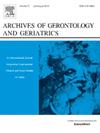Friends and trends: Friendship across life phases and cohorts
IF 3.8
3区 医学
Q2 GERIATRICS & GERONTOLOGY
引用次数: 0
Abstract
Objective
This study describes how subjective frequency of contact with friends changes over the lifespan, whether it has increased across cohorts, and if later-born cohorts maintain this contact into older ages.
Methods
Cross-sectional data from individuals aged 15–97 collected between 1968 and 2021 were used to create an age pattern, analyse changes within age groups, and compare self-reported age trajectories of frequent contact with friends across birth cohorts.
Results
Reported frequency of contact with friends follows a clear age pattern: decreasing from young adulthood, plateauing in midlife, and decreasing again in older age. Later-born cohorts are more likely to report frequent contact with friends, but this difference converges in older age. There is no strong evidence that later-born cohorts maintain frequent contact with friends into old age, though upcoming cohorts may show changes in this trend.
Discussion
As life expectancy and overall health in older age improve, understanding the role of contact with friends in supporting well-being becomes increasingly important. The convergence of the frequency of contact with friends across cohorts in older age could lead to unmet expectations of social contact in upcoming cohorts. Therefore, continued research and proactive measures to support social interactions throughout the ageing process could enhance social connectedness in ageing populations.
朋友和趋势:跨越生命阶段和群体的友谊
目的:本研究描述了与朋友联系的主观频率在一生中是如何变化的,它是否在队列中有所增加,以及晚出生的队列是否在老年时保持这种联系。方法从1968年至2021年间收集的15-97岁个体的横断面数据用于创建年龄模式,分析年龄组内的变化,并比较出生队列中与朋友频繁联系的自我报告的年龄轨迹。结果报告的与朋友联系的频率遵循一个明确的年龄模式:从青年开始减少,中年达到稳定,老年再次减少。较晚出生的人更有可能报告与朋友的频繁联系,但这种差异在年龄较大时趋于一致。没有强有力的证据表明,晚出生的人群在老年时仍会与朋友保持频繁的联系,尽管即将出生的人群可能会显示出这种趋势的变化。随着老年人的预期寿命和整体健康状况的改善,了解与朋友接触在支持健康方面的作用变得越来越重要。在老年人群中,与朋友联系频率的趋同可能会导致即将到来的人群对社交联系的期望未得到满足。因此,持续的研究和积极的措施支持整个老龄化过程中的社会互动,可以增强老年人的社会联系。
本文章由计算机程序翻译,如有差异,请以英文原文为准。
求助全文
约1分钟内获得全文
求助全文
来源期刊
CiteScore
7.30
自引率
5.00%
发文量
198
审稿时长
16 days
期刊介绍:
Archives of Gerontology and Geriatrics provides a medium for the publication of papers from the fields of experimental gerontology and clinical and social geriatrics. The principal aim of the journal is to facilitate the exchange of information between specialists in these three fields of gerontological research. Experimental papers dealing with the basic mechanisms of aging at molecular, cellular, tissue or organ levels will be published.
Clinical papers will be accepted if they provide sufficiently new information or are of fundamental importance for the knowledge of human aging. Purely descriptive clinical papers will be accepted only if the results permit further interpretation. Papers dealing with anti-aging pharmacological preparations in humans are welcome. Papers on the social aspects of geriatrics will be accepted if they are of general interest regarding the epidemiology of aging and the efficiency and working methods of the social organizations for the health care of the elderly.

 求助内容:
求助内容: 应助结果提醒方式:
应助结果提醒方式:


